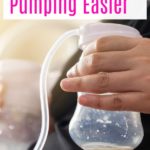Exclusive pumping is a lot of work. In addition to pumping, you need to prepare bottles, bottle feed your baby, wash bottles and pump parts, and manage your expressed breast milk. Here are seven things that you can do to make life as an exclusive pumper manageable, and make pumping easier.

This post may contain affiliate links, which means if you click a link and purchase something, I may make a small commission at no additional cost to you. I only recommend products I love! More information here.
7 ways to make pumping easier
Here’s what you need to do to make life as a pumping mom less stressful.
1. Go hands-free

This is absolutely the most important thing. If you’re going to be spending two hours per day tied to the pump, you need to be able to do other things at the same time, whether that’s giving your baby a bottle of milk, working on your laptop, or eating a sandwich.
Invest in a hands-free pumping bra (here is one that I love) or a hands-free pump, and free yourself to do other things while you pump. It’s life-changing!
There are two main kinds of hands-free pumping bras – the kind you wear all day (integrated with your nursing bra) and the kind you only wear while pumping.

More on hands-free pumping bras in the below stories.
2. Don’t be constantly washing pump parts
Washing your pump parts after every pumping session is a huge time suck. Here are some ways to avoid this.
Fridge hack
In between sessions, some people put their pump parts in a gallon-size zip-top bag or Pumparoo in the fridge, and just wash them every few sessions.

This is known as the “fridge hack,” and I often did this.
In September 2017, the CDC issued new guidelines recommending pump parts be washed after each use. In an FAQ, they say that “if you cannot clean your pump parts thoroughly after each pumping session, you can rinse and then refrigerate pump parts for a few hours between uses to help slow the growth of bacteria.”
Here is more information on following CDC recommendations more easily.
Get multiple sets of pump parts
Another option is buying extra sets of pump parts.
This way you can use clean parts whenever you need them and then wash everything in one big batch. (Plus, it’s always a good idea to have a backup in case your duckbill goes down the dishwasher.)
Also, pump parts don’t always work well when they are wet, so having multiple sets allows the parts time to air dry after washing.
You may be able to get extra sets of pump parts covered by insurance. More on this here.
Use the dishwasher
Another option is to wash your pump parts in the dishwasher.

Check your breast pump’s instruction manual first to make sure all of the parts are diswasher-safe. (The instruction manuals are usually available online if you search.) Then, you can put any safe parts in a mesh bag or diswasher basket, and clean them that way.
As a bonus, if your dishwasher has a heated drying cycle, that will take care of the sterilizing step, too!
Delegate/ask for help if possible
Finally, if you have a partner, enlist them to help with the washing!
For a long time, I considered the pump and everything that went with it “my thing.” Eventually I realized that since I was doing all of the work making the milk, he could help out by washing everything.
(After all – you made the baby’s dinner, so they can do the dishes, right?)
3. Pump into the bottles that your baby drinks out of
If you can, pump into the bottles that your baby will drink out out of – it saves so much time in terms of transferring milk and washing two sets of bottles.

If your baby won’t take the bottles that come with your pump, see if you can attach the bottles he or she likes to the it – you might be surprised. Dr Brown’s bottles (the narrow ones) screwed into my Medela pump parts, for example.
If that doesn’t work, keep trying the bottles that came with your pump every couple of weeks. Babies change all of the time, and you never know when they will surprise you!
You should also make sure that you have plenty of bottles – I would aim for twice as many bottles as your baby drinks in a day. That way you have plenty to store in the fridge, plenty to pump into, and you can wash them at all once.
(Another option for managing milk that a lot of exclusive pumpers find makes life easier is the pitcher method, where you store all the milk you pump in a large container in the fridge before prepping bottles. More on how to do this here.)
4. Set up a pumping station
Having all of your pumping stuff in one place can making getting your pumping sessions in a lot easier – you don’t need to run around and find your hands-free pumping bra, massagers, and chargers before you get started.

Some people use a mobile pumping cart or caddy so that they can move around the house as needed, rather than being stuck in one spot.
5. Get comfortable with pumping on the go
One thing that is challenging about exclusive pumping is that you can’t just leave the house without a plan for how and when you’re going to get your next session in. You either need to be careful to get home in enough time that you won’t get uncomfortable, or you need to be able to pump on the go.

Being able to pump on the go gives you so much more freedom. If you’ve never done it before, try something easy first, like pumping in your car while someone else is caring for your baby. Then you can work your way up to pumping anywhere you happen to be.
It’s also a good idea to have a designated pumping bag with your gear in it, so you can just grab it and go.
More on pumping on the go here.
(Also, just because you’re an exclusive pumper, it doesn’t mean that trips have to be stressful! Here is how to fly with your pump and how to travel with breast milk.)
6. Make everything routine
Carrying the mental load of pumping is work in and of itself – planning when and how to wash the bottles, remembering to put any extra milk in the freezer, etc.
One of the best ways to make exclusively pumping easier is to get into a routine and to have a system in place for things like getting the bottles washed or freezing your milk. This allows you do to things on autopilot rather than constantly having to carry the mental load.
For every task that you need to do on a regular basis, figure out the easiest way for you to do it, given everything else in your life.
For example, a routine for managing bottles might be that you wash all of your dirty bottles and pump parts during your baby’s morning nap.
A system for freezing breast milk might be that you freeze whatever extra milk you have on Mondays, Wednesdays, and Fridays after baby’s bedtime, so you don’t have to worry you’ll leave a random bottle in the fridge for too long.
Figure out what works for you, and then make it a routine.
Need help with exclusive pumping? Use EPUMP30 for 30% off
7. Have a back up plan
It’s the worst feeling when you sit down to pump at work and then find out that you forgot a crucial part at home. Or when you realize that you left your charger behind in a hotel, and now you have a day of travel and no way to pump.
It’s a good idea to have a back up plan. A few examples of things that you can do are to learn hand expression (there are videos on YouTube that can help), to keep extra sets of pump parts at work or wherever you might need them, or have a manual pump in your bag.
Once I figured these things out, life became a lot easier for me! If you have other tips, share them in the comments!
Want help putting together the perfect pumping schedule for you that saves your sanity AND your milk supply? Check out the Exclusive Pumping Playbook! Includes cheat sheets for setting up systems and routines to make things easier. Use EPUMP30 for 30% off.




















